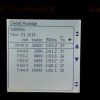Kozushi, without trying to sound like a pratt, your comment, "Running can wear out your knees a bit" made me think of Dan John in one of his books, when he talks about a lady who said squatting was hurting her knees. Dan takes a look at her squatting and says something like, " YOU are hurting your knees (by way of inefficient technique)"
I think too many people regard running ( and walking) as 'natural' as opposed to a movement skill to practice and refine like a KB snatch for example. And when injury/ pain occurs it's incorrectly assumed that 'running' causes issues.



